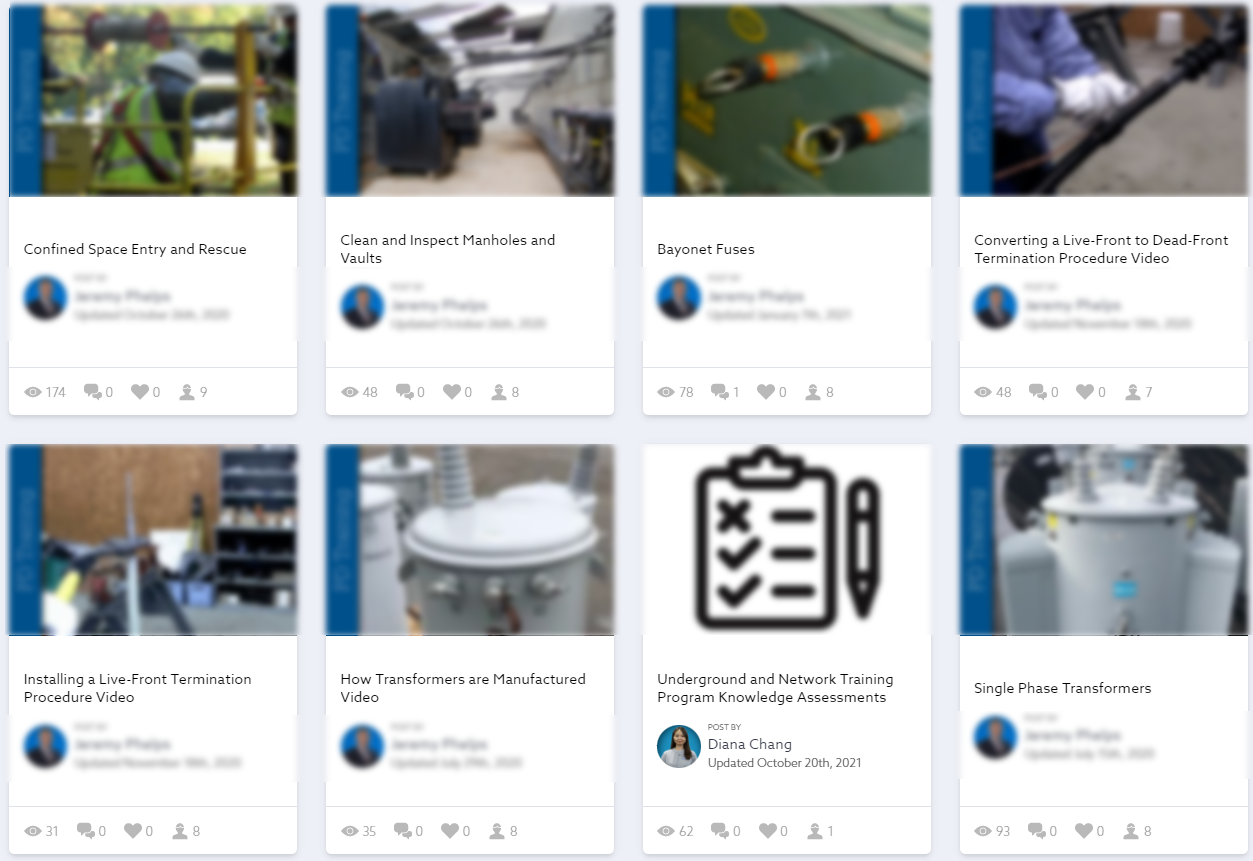Distribution Lineman Training Program Case Study
There are three different distribution line systems in Virginia and North Carolina: Network, Underground, and Overhead systems.
The company hires more than 200+ employees for Distribution Lineman positions every year, and the new hires get trained at the Training Center and the local office. Based on their role, the employees can work as certified Overhead Lineman, Underground Lineman, or Network Lineman after completing the training program.

Background Information
Industry: Power and Energy
Training Type: Certification for field employees
Training Delivery: Blended (Computer-based, Instructor-led, Performance-based training)
The company hires more than 200+ employees for Distribution Lineman positions every year, and the new hires get trained at the Training Center and the local office. There are three training programs for distribution linemen: Overhead, Underground, and Network Lineman Training Program. Since the program was developed a while, there was dated information, and the content didn’t align with knowledge assessment and field evaluation.
The total program duration for Underground Lineman is 480 hours with field practice periods at the local office, and for Network Lineman is 720 hours with field practice periods at the local office.
Role
My role for this project was Instructional Designer for Underground and Network Lineman Training Program, which includes User Research, Curriculum Development, Course Content Updates, Evaluation (Knowledge Assessment and Field Practice).
Duration: August 05, 2019 - August 03, 2020 (The new program launched in August 2020.)
Note: This project was collaborative with another Instructional Designer from Overhead Lineman Training Program to update the current Distribution Lineman Training Programs.
Challenges
I arranged a stakeholder meeting to understand the needs of this project. I included all the distribution program instructional designers, instructors, field supervisors, and managers as the stakeholders. After the stakeholder meeting, we comprehended two main challenges.
The main challenge was to update a large number of course materials. Also, the course's objective was to align with OSHA policy and procedures.
And another main challenge was that the training center didn't have enough Line Instructors to cover all three programs, especially, we had to find a guest Instructor for Network Lineman Training Program.
Solution
As a starting point, I reviewed all the existing materials with Line Instructor to help me understand the three programs. The Instructor and I noticed many course materials contain similar or the same objectives in that three curriculum. This is also appreciable for the knowledge assessment, field evaluation, and in-class activity. So even though the three programs are for different job positions, we were able to adopt the majority of courses from each program to reduce the duplicated effort.
And especially, the Underground and Network Lineman curriculum has 70 % similarity for course contents. Since there are 7 steps for the Network Lineman, there are only 4 steps for the Underground Lineman. And all the courses in Underground steps were aligned with the earlier stage of the Network Lineman Training Program. I suggested combining those two programs, and step 1 through 4 concentrates on Underground-focused materials, and step 5 through 7 concentrates on Network-focused materials. With this solution, we could hold more step 1 through 4 classes for both Underground and Network employees. Also, we don’t need to invite a guest instructor for Network Lineman Training Program that often.
Underground and Network Lineman Training Program Curriculum Comparison
New Underground and Network Lineman Training Program Guide
This program guide includes Program Description, Training Methods, Roles & Responsibilities, Curriculum, and Evaluation.
Underground and Network Lineman in the Knowledge Management System (Bloomfire)
Underground and Network Lineman - Course Materials
Underground and Network Lineman - Evaluation (Knowledge Assessment in SAP SuccessFactors & Field Evaluation in FPE)
Benefits
Its launch in August 2020 has been a year and half years. There are over 80 trainees in the Underground and Network Lineman Training Program. The number of new trainees at the training center increased 20% from previous years. The instructors at the training center covered steps 1 through 4 both in Underground and Network Lineman Training Programs instead of bringing the guest instructor. (Additionally, the new Network step 5 through 7 trainings are not held at the training center until 2023. I’m currently working on the guest instructor list and train-the-trainer session for network instructors.)
Also, the maintenance for each content material was more efficient than before since no more duplicated content exists. For example, suppose OSHA makes any updates for the confined space entry. In that case, the instructional designer doesn’t need to update all three courses in each program, just one sharable course material applied to all three distribution lineman programs.
Furthermore, since the underground and network lineman curriculum is combined, if the employees want to transfer from one to another, it is easy to give them credit for the course he/she already accomplished. For example, if an Underground employee, David, wanted to transfer to network lineman, he doesn’t need to complete the whole network training program. David only needs to complete the network step 5, 6, and 7. This is important for the field employees because it affects their responsibility in the field and the pay ranges.
Learner Feedback
After implementing those programs, I participated in the Underground and Network step 1 session. The session I participated has both underground and network line trainees. Here are some feedbacks I got from learners during the session:
The curriculum was clear, and easy to find each course material in the knowledge management system (the Source).
Since there were two different groups during the session, the discussion was more active in showing different perspectives.
Lastly, the network employees joined the company two weeks before this session started, and they were able to be assigned and scheduled for this session. (Previously, it takes longer for the Network employees)
Next Steps & Items to Consider
Periodical review for each course material to make those up-to-date
A train-the-trainer session for the Network instructors
Grandfathering some of the courses for the current employees in LMS










